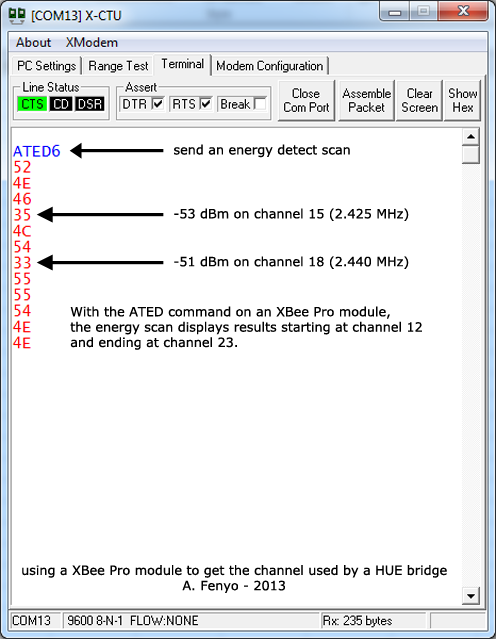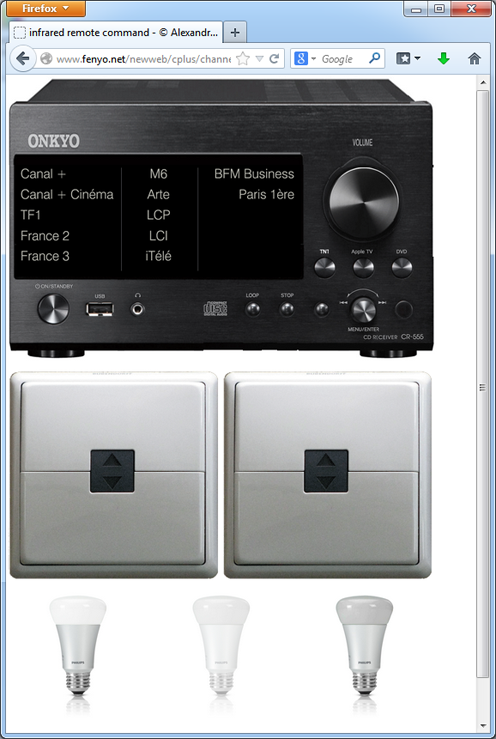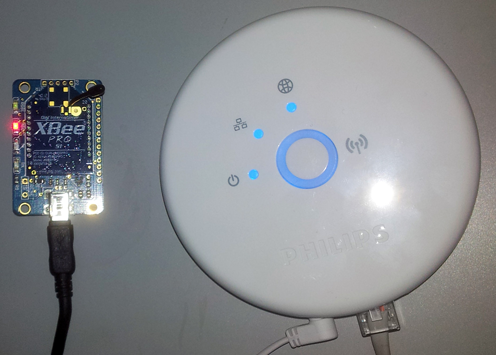Adding light control to my home automation system
| Integrating my new Philips HUE light bulbs in my home automation system, the story. Could also be subtitled "How to find the best carrier frequency to avoid collisions when simultaneously downloading a web page and switching the light on" !!! |

I already had 4 wireless networks at home, with center frequency specifically chosen to have very good channel rejections between them :
- the Wi-Fi 802.11g ESSID "ivrynet", that covers the 2nd floor and managed by my Internet box (FreeBox), with a spectral density centered at 2.422 MHz
- the Wi-Fi 802.11g ESSID "ivrynet extended", extending the wireless network to the 1st floor and managed by a Wi-Fi to Wi-Fi repeater, so the spectral density is the same as for ivrynet (consumer grade Wi-Fi repeaters include only one radio module).
- the Wi-Fi 802.11g ESSID "ivrynet extended 2", dedicated to real-time audio and video streaming (Apple AirPlay protocol, from our laptops to our Apple TV set top box), bridged with my Internet box by means of a couple of PLC modules, letting me use another channel than the one used by the two other ESSID, with a spectral density centered at 2.462 MHz. Using this frequency avoids collisions between streaming flows and Internet browsing.
- a 802.15.4 network, based on DSSS with BPSK modulation as a physical layer, made of XBee Pro modules (one coordinator and several endpoints), to automatically manage our window shutters and other multimedia devices. I had chosen a center frequency at 2.440 MHz, specifically to avoid interferences with my other Wi-Fi networks. The problem with my new light bulbs network is that it is based on the ZigBee network layer, itself based on the 802.15.4 data link layer. And Philips has chosen the same physical layer as the one used by my XBee Pro: DSSS with BPSK modulation in the 2.4 MHz band. With the Philips Hue system, there is no mean to choose the center frequency. As you can see on the following spectrum analysis of my electromagnetic environment, my Wi-Fi and 802.15.4 electromagnetic fields can not interfere, but the Hue network is deseperately set inside my Internet Box band:

I tried many times to shut down and restart the Philips Hue Zigbee IP bridge, but it desperately chooses the 2.425 MHz center frequency. Luckily, it does not interfere with my dedicated streaming ESSID (ivrynet extended 2), but it should do an energy scan before selecting an available channel, and its choice is awesome. For those interested to know the channel used by their HUE system, here is the way I did it. I used an XBee Pro module and made an active scan. Then I discovered my 802.15.4 network, so the other is the HUE one.


My light bulbs are now integrated in the whole home automation system. As you can see on the following picture, I can switch lights on/off by means of my watch:

The bulbs can also be switched on/off by means of the DECT phones (call 8 to switch them on/off) or by means of the Web interface:

Finally, as you can see on this picture, here are my two 802.15.4 bridges: the XBee Pro module (USB/802.15.4 bridge) and the HUE module (Ethernet/ZigBee bridge).

© Alexandre Fenyo - www.fenyo.net - 27/12/2013